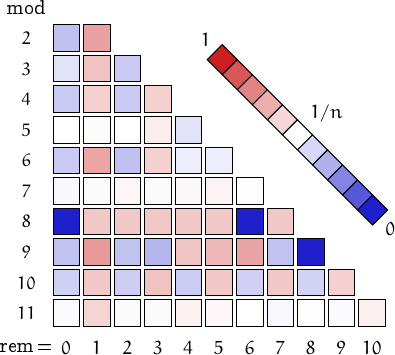The Bell numbers up to 1015 :
1, 2, 5, 15, 52, 203, 877, 4140, 21147, 115975, 678570, 4213597, 27644437, 190899322, 1382958545, 10480142147, 82864869804, 682076806159, 5832742205057, 51724158235372, 474869816156751.
Distribution of the remainders when the numbers in this family are divided by n=2, 3,..., 11. (I took into account 10000 values, from 1 to 1.59⋅1027664).
| n\r | 0 | 1 | |||||||||
|---|---|---|---|---|---|---|---|---|---|---|---|
| 2 | 3333 | 6667 | 2 | ||||||||
| 3 | 3076 | 4615 | 2309 | 3 | |||||||
| 4 | 1666 | 3334 | 1667 | 3333 | 4 | ||||||
| 5 | 1998 | 2047 | 1992 | 2172 | 1791 | 5 | |||||
| 6 | 1026 | 3077 | 769 | 2050 | 1538 | 1540 | 6 | ||||
| 7 | 1389 | 1405 | 1459 | 1405 | 1457 | 1472 | 1413 | 7 | |||
| 8 | 0 | 1666 | 1667 | 1667 | 1666 | 1668 | 0 | 1666 | 8 | ||
| 9 | 513 | 2563 | 513 | 256 | 1538 | 1796 | 2307 | 514 | 0 | 9 | |
| 10 | 663 | 1364 | 656 | 1445 | 604 | 1335 | 683 | 1336 | 727 | 1187 | 10 |
| 11 | 883 | 992 | 892 | 887 | 923 | 919 | 908 | 878 | 903 | 891 | 924 |
A pictorial representation of the table above

Imagine to divide the members of this family by a number n and compute the remainders. Should they be uniformly distributed, each remainder from 0 to n-1 would be obtained in about (1/n)-th of the cases. This outcome is represented by a white square. Reddish (resp. bluish) squares represent remainders which appear more (resp. less) frequently than 1/n.
e-mail: info -at- numbersaplenty.com • Privacy notice • engine limits